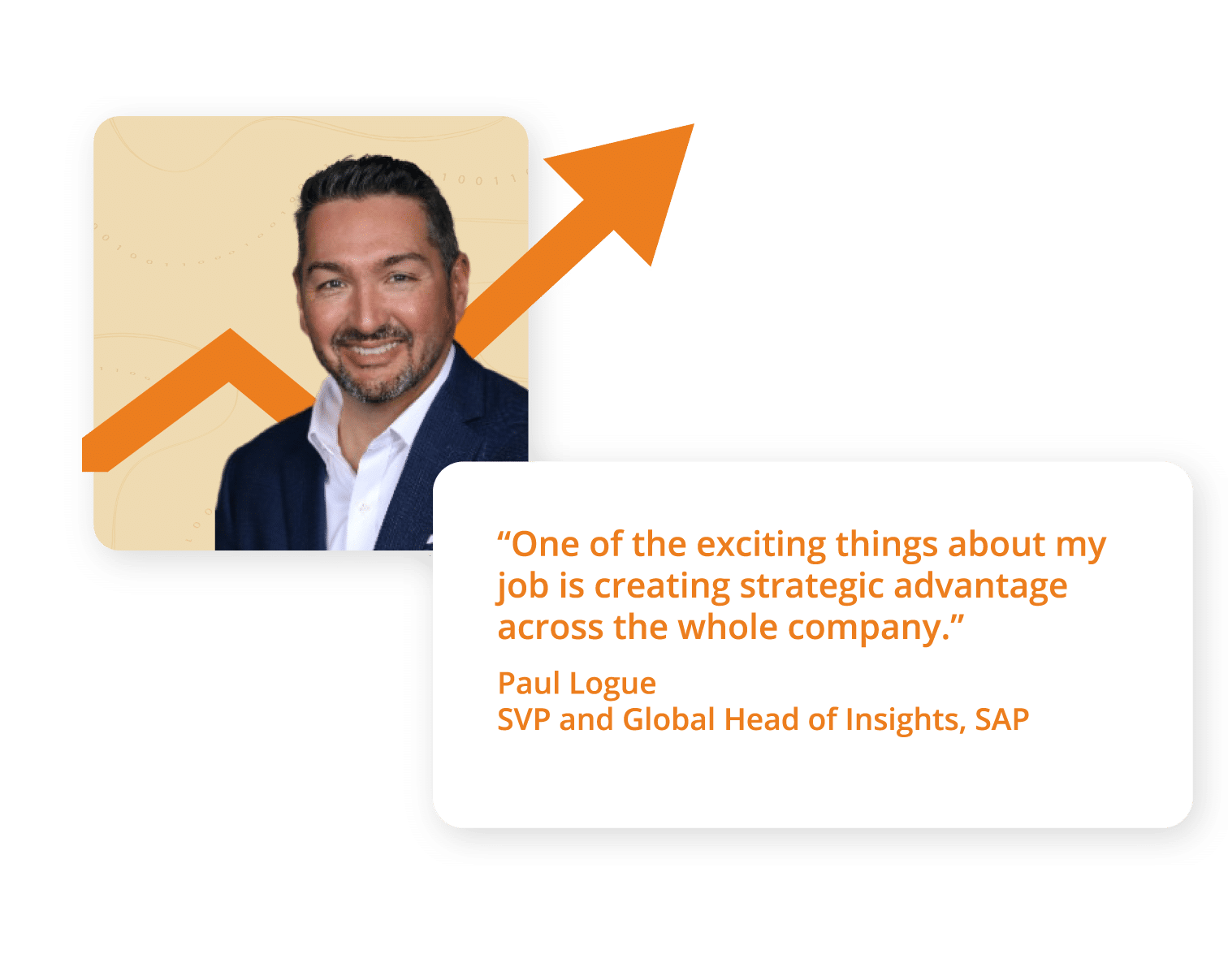Unlocking bottlenecks: How Intent data influences change, with Paul Logue
The only constant is change — and that goes for just about every industry. To remain successful, B2B intelligence needs to produce innovative ideas to move the business forward.
Paul Logue, SVP and Global Head of Insights at SAP, has made a career of coming up with new Intent-data-based strategies to increase his company’s productivity throughout the customer journey.
Recently on The Intent Data Exchange podcast, our Mike Burton spoke with Paul about his pivot from aerospace engineer to B2B intelligence, why bottlenecks lead to great innovation, and how to use data to strategically help the company.
Click here to listen to the full conversation with Paul. And never miss an episode of Intent Data Exchange by following us on Apple Podcasts, Spotify, our website, or anywhere you get podcasts.
The role of the intelligence function
At SAP, the intelligence function covers everything from customer intelligence, market intelligence, competitive intelligence, and sales intelligence. “We believe in the philosophy of connecting the dots, so we’ve put that all into one centralized powerhouse organization,” said Paul.
Intelligence sits in the office of strategy, so Paul reports to the Chief Strategy Officer, who reports to the CEO.
Intelligence is a central function at SAP — as it should be! Intelligence touches nearly every other function and acts as the innovation center for insights about enabling every workflow, activity, and employee with data-driven assets and intelligence.
On any given day, Paul might collaborate with the events team about the audience acquisition strategy or with HR about executive recruiting. “One of the exciting things about my job is creating strategic advantage across the whole company,” he said.
And all of that intelligence is built on data.
"Identifying the bottlenecks in your company are huge opportunities for innovation... and they have a multiplicative benefit."
Paul Logue, SVP and Global Head of Insights at SAP
Business lessons from bottlenecks
Paul didn’t start his career in B2B intelligence and strategy. An aerospace engineer by training, Paul landed what he first thought was the worst job in the industry: the battery department.
He quickly realized that he hit a “goldmine.” Batteries were the bottleneck to the entire industry in that every satellite (or even space station) was limited by its weakest battery. But the battery was where you could cause the biggest change.
Bottlenecks are data hotspots
If you want to go where the most data is likely to be, head straight to your industry’s bottleneck. Everyone is gathering data, taking measurements, and trying to solve the problem around the bottleneck. Thus, it’s the perfect spot for intelligence and strategy.
Bottlenecks are innovation hotspots
“A bottleneck has a multiplicative benefit,” Paul said.
If you improve 1% of something at the bottleneck of the funnel, it can impact 10 things at the next stage, a hundred things at the stage after that and so much more onward.
Intent data and change management
It’s not enough to turn data into intelligence. You have to persuade folks to adopt the new strategy, too.
Paul considers that change is a 60/40 challenge.
- The 40% is the technical: data, taxonomies, UX, and so forth.
- The 60% is the people, especially change management.
One thing that successful change always requires is plenty of time and self-belief. It can be discouraging to face consistent rejection over something you built to delight customers, transform how sales and marketing do their work and improve efficiency across the entire organization.
“We kept the same motto over and over, which was, ‘Crawl, walk, run,’” Paul said.
He rolled out his changes slowly and started with a small use case for a specific set of accounts. When it worked fantastically, the success story was shared and it grew. Soon enough, other regions or departments were curious and wanted to try it — “jealousy marketing,” Paul quipped.
Another of Paul’s effective change strategies is to measure everything. ”From day one, we’re going to instrument and measure the heck out of this. We’re going to do it upfront, and we’re going to live or die by the results of that,” he said.
The relentless commitment to measurement earns that intelligence objectivity and the data-based proof that the solution works from end to end.
Getting started with a data-based strategy
Beyond whether to use a vendor or what kind of data to start collecting, Paul remarked on the philosophies that drive successful strategy based on Intent data.
- Prioritize customer listening. Develop an extensive view of everything about your customers, and always think about the customer benefit — how the strategy will improve customer experience.
- Turn the buyer’s journey into your True North. From a business perspective, the buyer journey may seem fragmented, but to the buyer, it’s all connected.
“Customers have a growing expectation that those who serve them understand their buying journey as seamlessly as they’re experiencing it. That’s really hard to do, but that’s the goal,” Paul said.
Related resource: How Juniper Networks used Intent data to understand their buyer’s journey and deploy campaigns based on research activity
Click here to listen to the full conversation with Paul about using Intent data from bottlenecks to execute organization-wide change. And never miss an episode of Intent Data Exchange by following us on Apple Podcasts, Spotify, our website, or anywhere you get podcasts.

